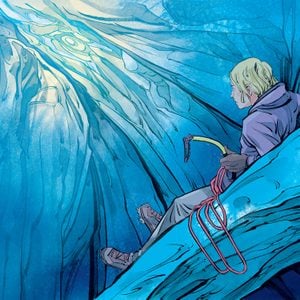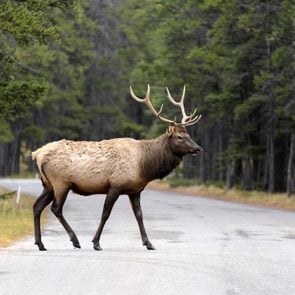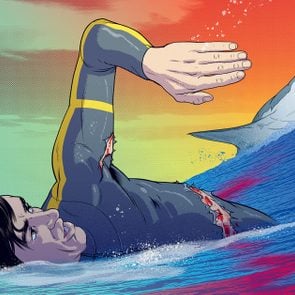The rock hills of Hueco Tanks rise dramatically above the scrubby Chihuahuan Desert in West Texas—four masses of weathered syenite that have long been a rock-climbing paradise.
In May 2015, Doug April was finishing a six-month stint as a camp host at Hueco Tanks State Park, living by himself in an RV. The lanky 46-year-old was divorced with three kids, the youngest in junior high. He had served two tours of duty in Iraq, where he saw plenty of things that were hard to forget. Throughout it all, climbing had been a refuge. Out on the rock, he could turn off his buzzing mind and just concentrate on what was in front of him.
Now that respite was coming to an end. April had officially left the army three weeks earlier, retiring as a major, but he wasn’t through with war zones. In a few weeks, he was headed to Afghanistan for three months to fly reconnaissance missions as a private military contractor. He wanted to make the most of his last days of climbing.
Around 8:00 a.m., April’s climbing partner, Ian Cappelle, pulled up to the campsite. The 38-year-old geologist had moved to El Paso with his wife, Malynda, five years earlier. Shortly after, while out climbing, he’d met April. They’d been buddies ever since.
Burly and bearded, Cappelle didn’t necessarily look the part of a climber. But as soon as he’d tried the sport, he was hooked. He regarded April as a kind of big brother—an experienced climber and generous teacher.
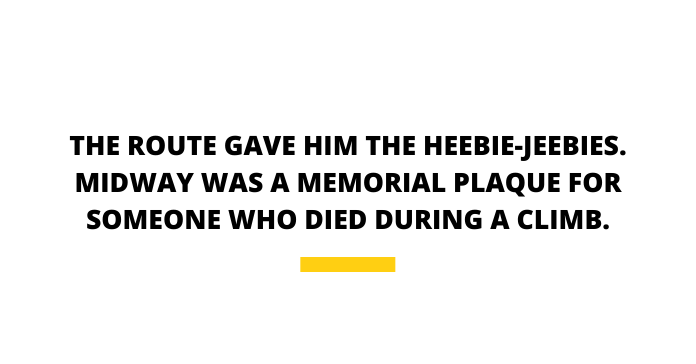
“What should we do today?” April asked as they packed their ropes that morning.
“Well, you’ve been up Indecent Exposure twice already,” Cappelle said. “I’d like to do that route.”
April paused. Indecent Exposure had always given him the heebie-jeebies. It wasn’t the most difficult route in Hueco Tanks, but it was probably the most intimidating. It had two “pitches,” or sections, and both had passages that left you hanging out over big 75-metre drops, unprotected. Midway along the route there was a plaque in memory of a University of Texas at El Paso student who had died while attempting it.
But when it’s one of your last climbs for a long time, you want to make it a memorable one.
The day was beautiful. The sun was just right, the breeze perfect. If Cappelle agreed to lead the first part of the climb, April said he would lead the second.
Cappelle climbed out to his right, his chalked fingers finding their way to the cliff’s handholds. He and April were tethered together for safety, with two lines of rope connecting them through belaying devices on each of their harnesses that would act as a brake, holding the rope tight if either of them fell.
As Cappelle led the way, he clipped the rope into metal anchors drilled into the rock face for protection. Twenty minutes into the climb, he saw the memorial plaque and silently paid his respects. He made it to the ledge that marked the end of the pitch and attached himself to an anchor. April followed and they paused for a moment to rest, 40 metres up in the air.

April led the second pitch. The hardest section came early on—a huge step to the right, followed by a few metres of slim, fingertip-and-toe edges. He’d had trouble there in past attempts, but this time he nailed it, making his way to a flake of rock about the size of a refrigerator.
“Oh man, that was great!” he called out across the chasm, a few metres above his partner and eight metres out to the right. Then: “This is weird. Where did all these bugs come from?” April slapped the back of his neck. He looked down and, in the next moment, watched in terror as a cloud of bees swirled out of the rock—more bees than he’d ever seen, like a scene from a horror movie. The swarm enveloped him in an instant, stinging him over and over again, the pain spreading across his neck and face and body.
Regular honeybees can sometimes be territorial, but Africanized bees are much more aggressive. They arrived in this hemisphere in 1956, when African bees introduced to Brazil to increase honey production escaped, bred with European honeybees and quickly spread across the Americas, making their way to the southwestern United States by the 1990s.
When Africanized bees sense a threat, they don’t just send a couple of bees to ward it off—they send hordes, chasing a person for up to 400 metres until the threat is eliminated. If someone’s stung 1,000 to 1,500 times, scientists estimate, they’ve got a fifty-fifty chance of dying. Since the 1950s, swarms of Africanized bees have been responsible for more than 1,000 deaths; there’s a reason they’re known as “killer bees.”
A moment after the bees swarmed, Cappelle watched in horror as April jumped off the ledge, feeling the jerk of tension in his harness as his partner’s weight pulled the rope taught. “Lower me, lower me, lower me, go, go, go!” April yelled.
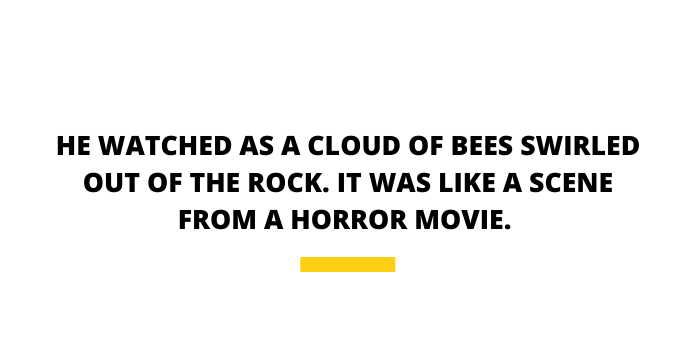
From his perch, a slim ledge about a metre across and just half a metre deep, Cappelle played out all 60 metres of rope, ripping it through the belaying device as fast as he could. Below him, the wall undercut the ledge he was standing on, and April disappeared from view.
That’s when Cappelle saw the first bee flying toward him. He stood as still as he could, figuring if he just ignored it, it should go away. Instead, it flew straight at him and stung him on the neck. The stings came quickly after that—one, two, three, four, and then a crescendo of pain as the bulk of the hive attacked him. Cappelle tried to cover his face, the high-pitched whine drowning out everything as the bees attacked his ears, eyes, nose and mouth.
His mind raced as the bees stung him. Why hadn’t Doug unclipped himself once he reached the ground? Once he unclipped, Cappelle could pull up the rope, anchor himself into the wall and rappel down to safety. But April was still hanging there, dead weight on the end of the rope.
Cappelle stood on the slim ledge and sucked water out of his climbing bottle, desperate to stay hydrated to stave off the effects of the venom. What do I do? What do I do? He reached up to brush the bees off his head and felt a halo of insect bodies an inch thick, stinging him over and over again. Call your wife, he thought. Tell her you love her. But what if he dropped the phone?
The toxins coursed through his bloodstream. At a certain point, the panicked thoughts subsided, replaced by a strange sense of calm. It was a terrible way to go. He was so sorry Malynda was going to lose him like this, but there was nothing he could do. The world shrunk around him, squeezing to a pinprick, and Cappelle blacked out, slumping down onto the rocky ledge.

Below him, April hung suspended in mid-air, two metres away from the wall and about 20 metres off the ground. He’d been stuck that way for about 10 minutes, and the bees hadn’t stopped stinging.
“Untie the blue rope!” he yelled up to Cappelle. He wanted Cappelle to use one of the ropes to rappel himself to the ground. But neither man could hear the other. All they could hear was the deafening buzz.
After so many stings, April’s body was becoming numb to the pain. He could feel the bees climbing all over him, but the stings hardly registered. One flew into his mouth—vibrating and fuzzy, with a slight flowery taste—and he quickly spat it out. After more than a dozen stings, people can experience vertigo, nausea and even convulsions and fainting. April had been stung hundreds of times. He pulled his ball cap over his face and tried to think.
He had always been able to keep his head in a bad situation. He’d crashed a helicopter in training and seen men die in combat. And no matter the danger, he’d always been able to flick a switch in his brain. Turn off the fear. Concentrate on what needs to be done.
What needed to be done now was clear: he had to climb down. The mountain was criss-crossed with climbing routes—he just had to find one. About five metres away, he spotted an anchor that was part of another route. He swung himself toward the bolt, caught it on the third try and clipped himself in. Then he released the ropes that were attached to Cappelle, leaving them dangling in the wind.
On a good day, this wouldn’t have been that difficult of a route, but this wasn’t a good day. He was pumped full of bee venom, his body inflamed and his mind swimming. He carefully picked out a route down.
The climb down took him about five minutes, but it felt like forever. By the time April made it to the ground, he was nauseous and nearly delirious. He stumbled toward the road, just as one of the park rangers pulled up.
“Ian,” April gasped, gesturing up at the cliff. He and the ranger called Cappelle’s name. They could see him up on the ledge. He was in the fetal position, a massive cloud of bees surrounding him. “Ian!” he yelled again. His friend didn’t move.
April did the math in his head. Someone had already called search and rescue, but it would take them about an hour to get a team from El Paso. And to get a team that could safely climb down to Cappelle and remove him? That could take climbers who didn’t know the area a few hours more. Cappelle likely didn’t have that much time.

April knew what he had to do. “Drive me back to my car,” he said to the ranger. “I’ve got another rope in there. I’ll go get him.”
April scrambled up the rocks as fast as he could. He’d decided to hike another route up the back of the mountain, then rappel down to Ian. He wore the park ranger’s radio, as well as a mesh net that he pulled over his ball cap.
Part way up the trail, he ran into two other climbing friends and conscripted them into the rescue plan. By the time they reached the top, it had been about 45 minutes since the start of the attack, and April had no idea if his friend was alive or dead. Even in his nauseous state, it didn’t cross his mind to ask one of his fellow climbers to head down instead. It was his partner down there—he would be the one to go and get him. April set an anchor at the edge of the cliff and clipped himself in. One of the other climbers began belaying him down.
For about the first 15 metres, Cappelle was out of sight. Finally, the cliff grew steep enough that he could see his partner, still motionless, covered by a swirling blanket of bees. “Ian!” he yelled. And this time Cappelle looked up.
“He had the same look I’ve seen too many times in combat, where someone’s been blown up or shot,” April remembers. It’s not fear, exactly—more a look of pure incredulity. How the hell did this happen to me? “That’s how he looked at me. Then he put his head back down.”
April made his way down to the ledge. The bees were all over him again, but by now he was entirely numb to them. He attached Ian to his belay device. “I’m going to get you out of here,” he said. Cappelle was just conscious enough to follow April’s simple instructions, while April carefully lowered him 40 metres down to the ground. Below them, the first ambulance was just pulling up.
April watched as the rangers and paramedics collected Cappelle. Then he lowered himself as quickly as he could. By the time he reached the ground, Cappelle was in a helicopter destined for the hospital in El Paso. It was only then that the search-and-rescue team arrived.
April turned down the paramedics’ advice to go to the hospital. Although he felt faint, he didn’t believe he was going to die anytime soon.
In the parking lot, he ran into two climbers who had wilderness first aid training. April stripped down to his boxers. The best way to remove the stingers, they told him, wasn’t to use tweezers, which squeezes the poison from the venom sacks into your body. The two men used their credit cards to scrape him down, sloughing off hundreds of stingers into the desert sand.
At the hospital, doctors estimated that Cappelle had been stung more than a thousand times—a high enough dose to be lethal. He had been lucky. And with a day or two to flush it out of his system, he would be fine.
Months later, after April returned from Afghanistan, the men planned a climb—back at Hueco Tanks.

They took a different route this time, and any trepidation they might have felt being out there dissipated in the fresh air of another perfect day. They reached a little alcove high above the desert and sat down to rest.
In the months since the attack, Cappelle had had plenty of time to think about what could have happened if April hadn’t come back for him that day. His one memory after he blacked out is a flash of a thick carpet of dead bees covering the cliff ledge and then, entering the picture, April’s red shoes.
On the ledge, he tried to tell April how much he appreciated what he’d done, but his friend waved him off. It hadn’t even been a choice. “There was just no way he wasn’t going to try to help me,” says Cappelle.
The two men took in the view. Out there, in the Basin and Range Province, just a little elevation gives you sweeping vistas in every direction. The Franklin Mountains sat out to the west, hazy and indistinct. To the north, 140 kilometres away, you could see the faint outline of the Sacramento Mountains silhouetted against a sky that seemed endless. The sun was just right, the breeze light. They stood up again, the rope strong and secure between them, and went back out on the rock.
Next, read about how this rescuer refused to quit searching when a scuba diver got lost in a cave.
A white shark is human fear made flesh. It shears the water like a missile targeting its prey, with conveyor-belt rows of serrated teeth and skin so rough it was once used as sandpaper. From a primordial perspective, our fear of these creatures is understandable. But we’re a peculiar species, fascinated by what terrifies us. From Jaws to Shark Week, sharks occupy an intersection between terror and entrancement. So when one starts tweeting, of course we follow.
In March 2017, an American research group called Ocearch caught a 600-kilogram, 3.7-metre-long white shark off Hilton Head Island, South Carolina. They then bolted a flashlight-sized satellite transmitter to his dorsal fin and named him Hilton. That same month, they gave him a Twitter account run by a team of staff, volunteers and scientists. Thanks to Ocearch’s Global Shark Tracker app, anyone in the world could now watch Hilton’s migration as he swam (and tweeted) along Nova Scotia’s Atlantic coast.
With nearly 50,000 followers, Hilton is a minor celebrity and unofficial mascot to Nova Scotia’s shark fans. The staff at Ocearch use the Twitter account to present Hilton as a jaunty guy on the hunt for food and love. (A typical post goes, “Just gave the last fish a 15 second head start. Feelin’ sporty, I think I’ll give the next one 25 seconds.”) Hilton’s not the only social media star. Ocearch has launched 27 Twitter accounts for tagged sharks.
Thanks in part to its savvy marketing, Ocearch has become one of the best-known, and most controversial, ocean-research outfits in the world. (The name is a portmanteau of “ocean” and “research.”) At the non-profit’s helm is an equally polarizing figure named Chris Fischer. Instead of fearing sharks, he wants us to save them.
Fischer’s kingdom is the MV Ocearch, a 38-metre shark-research vessel. He speaks with a light Kentucky drawl and wears a hoodie and ball cap emblazoned with the logos of corporate sponsors. He often invokes Jacques Cousteau, the beloved filmmaker, television host and ocean adventurer, as the inspiration for Ocearch. But an obsession with disruption and growth makes Fischer more like a startup founder.
Fischer found his calling while working as the host of Offshore Adventures, a fishing show on ESPN 2. In 2005, as part of the show, he’d bring biologists on trips to help the crew catch fish for research. It was from those scientists that Fischer learned how ocean ecosystems could hinge on apex predators, such as white sharks.

Those sharks were in trouble from finning—the term for hunting sharks only to cut off their fins and dump them back in the ocean alive—and overfishing. Lose these balance keepers, the scientists argued, and the ecological webs around them collapse.
This inspired Fischer to turn his ship into a floating lab he eventually renamed the MV Ocearch. The boat became the base from which he filmed his shark-focused docuseries-meets-reality-television show, Expedition Great White, which premiered on National Geographic in 2010 (it was later relaunched as Shark Men and then again as Shark Wranglers). “I was just young enough and dumb enough,” he says, “that I set a noble goal to pour the world’s oceans into people’s lives on a scale not seen since Cousteau.”
Scientists have been analyzing white-shark populations since the 1970s in the northwest Atlantic Ocean, counting animals snagged as bycatch on longlines offshore and extrapolating those numbers to track population trends. But this method is imperfect, and it doesn’t account for sharks that stay closer to the coasts. Reliable population numbers for white sharks in this region are non-existent. That’s part of the reason why Ocearch and other researchers are instead focused on tagging: they’re trying to solve the bigger mystery of where white sharks are going and breeding. And, it was savvy of Ocearch to choose a predator that’s also a source of public fascination.
Ocearch’s tagging methods are unconventional, and that’s exactly why fans tuned in week after week to watch Fischer catch sharks on TV. Many researchers embed pop-up satellite archival (PSAT) and acoustic tags under a shark’s skin with a harpoon while it’s swimming or while it’s restrained along the side of a boat.
Instead of this method, Ocearch hooks the shark and lures it over to the ship and onto a specialized hydraulic lift. They then take samples, including blood, parasite and muscle. And in addition to the PSAT and acoustic tags, they bolt a smart-position and temperature-transmitting (SPOT) tag to its dorsal fin. By the time the shark is lowered back into the water, the SPOT tag is also pinging data to Ocearch’s app—and, soon after, a Twitter account.
Lifting a 500-plus-kilogram predator out of the ocean is inevitably a frenzied scene, and things didn’t always go smoothly. Shark Men, the precursor to Shark Wranglers, featured Fischer, his crew and shark biologist Michael Domeier, who advocated for taking sharks out of the water for SPOT tagging. The series seemed to exaggerate petty conflicts and dramatized the danger of working with white sharks.

In the first episode of the second season, the crew accidentally lodged a hook in the back of a shark’s mouth while tagging near the Farallon Islands, off San Francisco. Part of the hook remained lodged in place after the shark swam off, and a local marine sanctuary suspended Ocearch’s tagging permit until the organization altered its techniques—all while the cameras were rolling. Later in the episode, a stressed Domeier told Fischer that his professional reputation is on the line. “My name is on all these permits,” Domeier says. “You guys can go home and make a fishing show—I’m stuck with this mess.”
Other researchers called out Domeier for using such invasive tagging methods. Meanwhile Fischer earned a reputation as a maverick. Since the Farallon incident, Ocearch has stirred up controversy almost everywhere it has gone. It has been criticized for chumming—dumping large amounts of fish guts and blood into the ocean as a shark attractant. In South Africa, residents blamed Ocearch when a bodyboarder was killed by a shark near Cape Town (the city stated there was no evidence Ocearch’s chumming actually caused the attack).
Fischer’s second run on reality TV ended after four seasons and two years, but he concedes this was for the best. “You can’t get meetings with policy-makers and presidents if you’re the wacky guy on TV on Tuesday nights,” he says.
But leaving television also put his organization in a precarious financial situation, so he started selling sponsorships in exchange for “brand-integrated content.” In effect, Ocearch became a conservation group with an advertising arm. Today, the MV Ocearch is plastered with sponsors’ decals, including outdoor-recreation-gear brands.
Fischer has figured out a way to turn corporate money into funding for both scientific research and online entertainment for thousands of people. Ocearch knows that popularizing a single shark like Hilton means an audience is more likely to care about the larger issue. It also allows Ocearch to run a huge ship and buy the best equipment for scientists who work on the boat. And the more exciting the results those scientists produce, and the more people who are following their work, the more sponsorships Ocearch can attract to sustain future work.
The organization has made a point of emphasizing how it collaborates with the wider research community. Any scientist anywhere can access its app’s tracking data, for instance. Of course, scientists collaborate all the time. In December 2018, 46 researchers from all over the world released a paper laying out the work they all believe needs to be done in white-shark science. But none of that impresses Fischer.
“I’m talking about radical collaboration,” he says. “They’ve come together, and yes, they’re collaborating, but they have no scale.” He wants scientists all over the world sharing data with each other through Ocearch.

In mid–September 2018, Ocearch brought its bravado to Nova Scotia as part of its ongoing North Atlantic white shark study. It arrived on the province’s south shore with a permit from Fisheries and Oceans Canada (commonly known as the Department of Fisheries and Oceans, or DFO) to tag up to 20 white sharks. Ocearch anchored near Hirtle’s Beach, a swimming and surfing hotspot, and the LaHave Islands, popular with kayakers, snorkellers and scallop divers—and began chumming.
A man named Seth Congdon says that he and two friends were mackerel fishing when a crew member from Ocearch’s ship told them about a white shark they’d tagged. When Congdon joked that they’d been swimming nearby earlier that day, he says the crew member warned they’d been chumming pretty hard and recommended against going in the water.
Congdon’s friend and local surfer Jefferson Muise was especially troubled and went to CBC when neither Ocearch nor the DFO got back to him with answers. The community suddenly realized how little it knew about Ocearch’s operation. Ocearch’s then-chief science adviser (he is now the chief scientist), Bob Hueter, responded by telling a community newspaper that the account was a “complete fabrication; never happened.”
Muise isn’t naive. He knows that in the summer and fall, when he’s out in the waves, he’s sharing the water with white sharks. But he’s also not wrong to be concerned. While scientists are still debating whether chumming could endanger people close to shore by altering shark behaviour, it’s not something many other researchers are willing to risk.
Heather Bowlby, head of the DFO’s Canadian Atlantic Shark Research Lab, travels at least three nautical miles offshore when baiting for white sharks. (She also notes that, unlike chumming, with baiting, fish is placed on a hook to lure an animal. She also says she doesn’t chum at all for white sharks.)
And Chris Lowe, the director of the Shark Lab at California State University, Long Beach, who regularly tags sharks off the coast of Los Angeles, says, “There’s no way I’m going to chum or bait along a public beach.”
Fischer dismisses the criticism. In his mind, any biologist not interested in working with Ocearch is a selfish data hoarder who is more interested in getting ahead than saving sharks. “We had to totally disrupt the whole way science was done,” he says. “If you really look at any of them, they all have different agendas. It has nothing to do with sharks.”
Tell that to biologists who have dedicated their lives to this work and you’ll get a different opinion. Lowe says Ocearch isn’t so avant-garde but, rather, at its core, is a scientific lab like any other. The only difference is that its facilities are mobile, allowing it to flit from location to location—armed with cameras and corporate sponsors and Twitter accounts—leaving resentment in its wake.
As of this past spring, Ocearch was still tagging and tracking sharks around the world, and touting “#factsoverfear.” But Hilton the white shark’s Twitter account has been silent since August 2020. Ocearch had lost track of him. The pings from his transmitter had gone silent.
© 2019, Chelsea Murray. From “Twitter Sharks,” The Walrus (June 3, 2019), thewalrus.ca
Next, find out if sharks really do smell blood.
